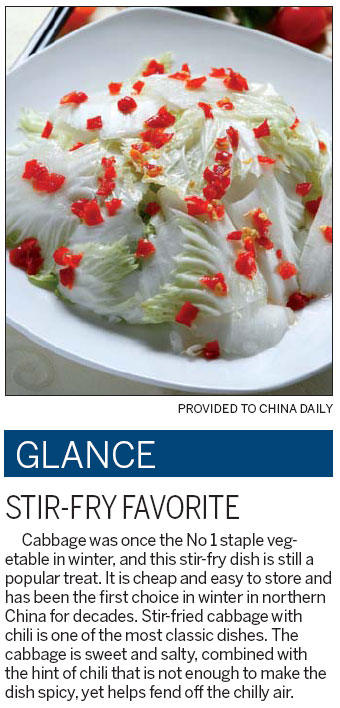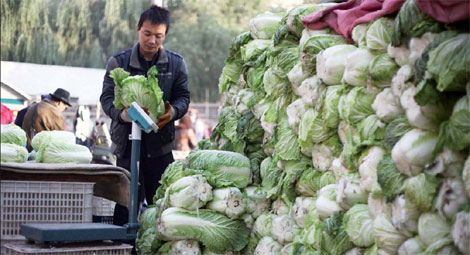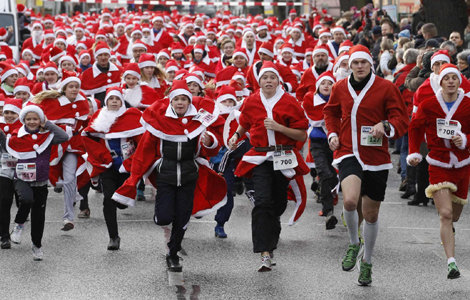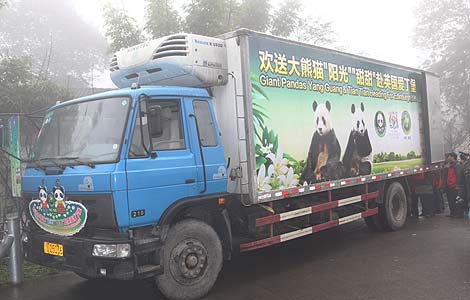Greener pastures
Updated: 2011-12-02 07:35
By Sun Yuanqing (China Daily)
|
|||||||||
|
Because of oversupply this year, cabbages are no longer stored outside, and inside apartment corridors, this winter. Wang Jing / China Daily |
The oversupply of the humble cabbage reflects China's multiple choices and changing fortunes
As winter approaches, Cui Jintian, 63, is busy piling up Chinese cabbages outside his yard in downtown Beijing. "I bought about 50 kilos this year, much less than I used to," he says. The Beijinger has been storing Chinese cabbages every winter since he was a kid.
Cui recalls the days when his mother had to learn to vary every meal using cabbage as the choices of leafy vegetables available in the north during the winter months were very limited. Times have changed. Now more than 20,000 tons of fresh vegetables, of about 300 kinds, are sold daily in the capital.
"With growing wealth over the past few decades, greenhouses were built in the nearby suburbs and southern vegetables are transported here daily," says Liu Tong, spokesman for Xinfadi, the largest agricultural wholesale market in Beijing. "People no longer hoard Chinese cabbages as fresh vegetables are available all year round."
Now cabbages account for only 7 to 10 percent of all vegetables sold in Beijing, statistics show. Twenty years ago the figure was 95 percent and 10 years ago between 50 and 70 percent.
Loads of cabbages produced in northern China head to South Korea, where it seems pickled cabbages have remained the national delicacy.
Now, while cabbage is no longer occupying the Chinese dining table, it still serves as a fix-it-all vegetable for families and restaurants.
It is estimated that about 100 different dishes can be made from cabbage.
Those include stir-fried cabbage with garlic, stewed pork with cabbage, cabbage and tofu soup, cabbage with dried shrimp, cabbage salad, cabbage with mustard, pickled cabbage and the big treat, dumplings of cabbage and minced pork.
Before the Ming Dynasty (1368-1644), northern cities like Beijing were mainly used for military purposes and fresh vegetable supply was barely considered as important during wartime. After Beijing was chosen to be the capital of both the Ming and Qing (1644-1911) dynasties, more people moved to the area and the demand for vegetables grew.
Most of them had to eat pickled or salted vegetables in winter. But the cabbage was different. It was a tough, durable vegetable that could survive a North China winter.
After 1949, when the People's Republic of China was founded, even more people moved to the area. Along with living standards, the requirements for food supply also rose and Chinese cabbage became people's first choice in winter because it was cheap and easy to store,
Rich in vitamin A and C and dietary fiber, the vegetable helped generations of Chinese people get through the freezing winters at a time when food was still a problem.
Fang Chengde, 75, a Shanghai native who has lived in the capital for more than 50 years, remembers the days when cabbages were one of the staple vegetables in winter. "For a two-child family you had to store thousands cabbages, potatoes and leeks by the end of November. Otherwise you would run out of food by the end of winter and the whole family would starve."
Fang says neighbors argued over the limited space in doorways to store the thousands of kilos of cabbages as this was the only way to protect the vegetable from the chill and last through long winter.
"All we had were seasonal vegetables. Beans, cucumbers and tomatoes in summer, and cabbages, potatoes and carrots in winter."
In the 1990s, the emergence of row upon row of greenhouses in the city's suburbs added largely to the supply of fresh vegetables all year round, and cabbages were no longer the staple vegetable in winter.
"We hardly eat cabbages now let alone store them. The market is full of fresh vegetables and my families prefer vegetables like tomatoes and eggplants," Fang Chengde says.
"I only bought one today so we wouldn't run out of vegetables in the next few days as the weather forecast said it's going to snow and I might not be able to get outdoors."
Rapid urbanization has led to a decline in cabbage-growing in Beijing, yet supply still far outsrips the demand. Due to the glut, the retail price of cabbage once dropped to as low as 0.24 yuan (4 cents, 0.03 euros) a kilogram in Beijing. It was dubbed as "patriotic vegetable" or "kindness vegetable" in the capital and consumers even received subsidies from the government to buy it.
In a market in Beijing's Chaoyang district this week, piles of cabbages were stacked high and were not attracting many buyers. "Cabbages are not very popular. We can only sell about 20 a day," says Wu Xiujuan, a vegetable retailer.
The average retail price of Chinese cabbage fell to 0.4 yuan a kilo this year, only a third of what it was last year.
Xu Yuguang, a farmer in Shandong province, is one of the many rural people who has suffered from falling prices. This year he received only 0.14 yuan wholesale for the 15,000 kg his family harvested. "The three mu (0.2 hectare) of Chinese cabbage cost me about 4,500 yuan to grow," Xu, 41, told China Daily early this year. "Now I'm selling them at 2,100 yuan in total."
Cui says his family was one of the few in the neighborhood who still stocked up on cabbages. "For people of my age, it's like rice, cheap and handy. You can have it everyday and it doesn't taste too bad."













